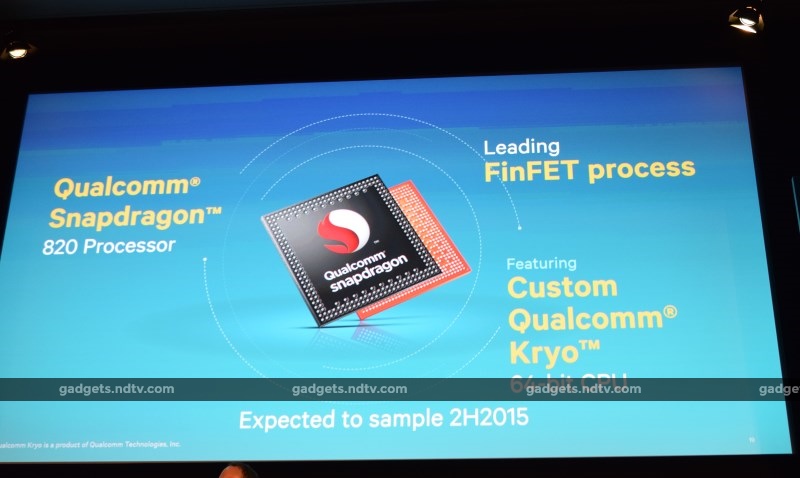- Home
- Mobiles
- Mobiles News
- Qualcomm Snapdragon 820 SoC's Kryo CPU Detailed
Qualcomm Snapdragon 820 SoC's Kryo CPU Detailed

The company has slowly been releasing details of the various components of its upcoming Snapdragon 820, starting with the integrated Adreno 5-series GPUs. Information about the Hexagon 680 DSP and a hardware security layer called Smart Protect has also been made public. Now, Qualcomm seems ready to divulge information about the CPU itself.
All mobile CPUs must aim to deliver higher performance and lower power consumption in today's highly demanding smartphone market. Qualcomm is promising 2x improvements on both fronts compared to the beleaguered Snapdragon 810, while remaining cool enough to enable smartphone manufacturers to design ever-thinner models.
The first-generation Kryo in the Snapdragon 820 will be a quad-core, 64-bit CPU and will be manufactured on a modern 14nm FinFET process. It will reach speeds of up to 2.2GHz. It is designed to be tightly integrated with the Adreno 530 GPU and Hexagon 680 DSP as well as other special-purpose logic such as the camera image processor and video decode blocks, in what the company calls a heterogenous computing arrangement. This allows each specialised component to take on tasks suitable to it while maintaining cohesion across the board.
To enable that, Qualcomm has developed what it calls the Symphony System Manager, which will oversee how tasks are scheduled and allocated to each component of the SoC. This should lead to better performance compared to systems that force all tasks to run on the same general hardware or shuttle data between discrete components. Being able to activate and shut down different logic areas on demand should also positively affect power consumption and heat dissipation.
One of the killer applications that the Snapdragon 820 will enable is Qualcomm's Zeroth platform, a machine-learning algorithm designed to enable new context-aware applications. One example shown already such is a photography app that can change settings based on conditions and subjects it detects, while other potential uses could include security apps that recognise and authenticate users based on subtle cues, and handwriting recognition that learns individual styles and patterns. Qualcomm also talks about virtual reality, computer vision, and advanced imaging.
While the Snapdragon 820 will undoubtedly find its way into the next generation of flagship smartphones and tablets from a variety of manufacturers, Qualcomm's ambitions extend into other segments, such as automotive and embedded commercial applications. Variants of the Kryo CPU will be applied to other Snapdragon SoCs, bringing premium features lower and lower down the product stack over time. Devices based on the Snapdragon 820 should be available in late 2015 or early 2016.
Catch the latest from the Consumer Electronics Show on Gadgets 360, at our CES 2026 hub.
- Samsung Galaxy Unpacked 2025
- ChatGPT
- Redmi Note 14 Pro+
- iPhone 16
- Apple Vision Pro
- Oneplus 12
- OnePlus Nord CE 3 Lite 5G
- iPhone 13
- Xiaomi 14 Pro
- Oppo Find N3
- Tecno Spark Go (2023)
- Realme V30
- Best Phones Under 25000
- Samsung Galaxy S24 Series
- Cryptocurrency
- iQoo 12
- Samsung Galaxy S24 Ultra
- Giottus
- Samsung Galaxy Z Flip 5
- Apple 'Scary Fast'
- Housefull 5
- GoPro Hero 12 Black Review
- Invincible Season 2
- JioGlass
- HD Ready TV
- Laptop Under 50000
- Smartwatch Under 10000
- Latest Mobile Phones
- Compare Phones
- OPPO Reno 15 Pro Max
- Honor Win RT
- Honor Win
- Xiaomi 17 Ultra Leica Edition
- Xiaomi 17 Ultra
- Huawei Nova 15
- Huawei Nova 15 Pro
- Huawei Nova 15 Ultra
- Asus ProArt P16
- MacBook Pro 14-inch (M5, 2025)
- OPPO Pad Air 5
- Huawei MatePad 11.5 (2026)
- Xiaomi Watch 5
- Huawei Watch 10th Anniversary Edition
- Acerpure Nitro Z Series 100-inch QLED TV
- Samsung 43 Inch LED Ultra HD (4K) Smart TV (UA43UE81AFULXL)
- Asus ROG Ally
- Nintendo Switch Lite
- Haier 1.6 Ton 5 Star Inverter Split AC (HSU19G-MZAID5BN-INV)
- Haier 1.6 Ton 5 Star Inverter Split AC (HSU19G-MZAIM5BN-INV)












